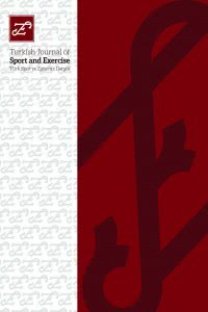The effect of maximal leg press strength training on bilateral deficit
___
1. Aşçı A. Çabuk Kuvvet Gelişiminde Kuvvet Eşiğinin Belirlenmesi. Doctoral Thesis, pp. 24-28, 2001.2. Gündüz N. Antrenman Bilgisi, II. Baskı, İzmir: Saray Kitap Evi, 1997.
3. Henry FM, Smith LE. Simultaneous, separate bilateral muscular contractions in relation to neural overflow theory and neural specifity. The Research Quarterly, 1961; 31(1): 42-46.
4. Howard JD, Enoka RM. Interlimb interactions during maximal efforts. Medicine and Science in Sport and Exercise, 1987; 19: 53-58.
5. Howard JD, Enoka RM. Maximum bilateral contractions are modified by neurally mediated interlimb effects. Journal Apply Physiology, 1991; 70(1): 306-316.
6. Muratlı S, Toroman F, Çetin E. Sportif hareketlerin biomekanik temelleri. Ankara: Bağırgan Yayınevi, 2000.
7. Oda S, Moritani T. Moment related corticol potentials biomekanik temelleri. Ankara: Bağırgan Yayınevi, 2000. during handgrip contractions with special to force and electromyogram bilateral deficit. European Journal of Applied Physiology and Occupational Physiology, 1995; 72(1- 2): 1-5.
8. Ohtsuki T. Inhibition of individual fingers during grip 9. Ohtsuki T. Decrease in grip strength induced by strength exertion. Ergonomics, 1981; 22: 21-36.
9. Ohtsuki T. Decrease in grip strength induced by simultaneous bilateral exertion with reference to finger strength. Ergonomics, 1981; 24(1): 37-48.
10. Ohtsuki T. Increase in simple reaction time of knee extension induced by simultaneous bilateral performance. Motor Skills, 1981; 53: 27-30.
11. Ohtsuki T. Decrease in human voluntary isometric arm strength induced by simultaneous bilateral exertion. Behavioural Brain Research, 1983; 7: 165-178.
12. Peter FV, Scott PM. Maximal and submaximal expressions the bilateral deficit phenomenon’. Presented at the 23rd Annual Meeting of the American Society of Biomechanics University of Pittsburgh, October 21-23, 1999.
13. Sale DG, McDougall JD. Specificty in strength training: a review for the coach and athlete. Can J Applied Sports Sciences, 1981; 6: 87-92.
14. Sale DG. Neural adaptation to resistance training. Medicine and Science in Sports and Exercise, 1988; 20: 135- 145.
15. Secher NH. Isometric rowing strength of experienced and inexperienced oarsmen. Medicine and Science in Sports, 1975; 7: 280-283.
16. Secher NH, Rorsgaard S, Secher O. Contralateral influence of type I muscle fibers during maximum voluntary extension of the legs. Acta Physiology Scandinavian, 1976; 96: 20A-21A.
17. Secher NH, Rorsgaard S, Secher O. Contralateral Influence of curarized muscle fibers during maximal voluntary exertion of the legs. Acta Physiology Scandinavian, 1977; 103: 456-462.
18. Secher NH, Rube N, Elers J. Strength of two and one leg extension in man. Acta Physiology Scandinavian, 1988; 134: 333-339.
19. Thorstensson A, Grimby G, Karlsson J. Force- velocity relations and fiber composition in human knee extensor muscles. Journal of Applied Physiology, 1976; 40: 12-16.
20. Vandervoort AA, Sale DG, Moroz J. Comparison of motor unit activation during unilateral and bilateral leg extension. Journal of Applied Physiology, 1984; 56: 46-51.
- ISSN: 1300-9915
- Yayın Aralığı: 1
- Başlangıç: 2018
- Yayıncı: -
METİN KAYA, AHMET UZUN, Latif AYDOS, Ulunay KANATLI, Erdinç ESEN
Reliability and validity of recreational Fishing Motivation Scale in Turkish population
Comparison of respiratory functions of athletes engaged in different sports branches
TÜLİN ATAN, PELİN AKYOL, MEHMET ÇEBİ
Süleyman CAN, MERİÇ ERASLAN, MUSTAFA BAŞ
The effect of maximal leg press strength training on bilateral deficit
HAMİT CİHAN, Rasim KALE, İBRAHİM CAN, ERDAL ARI
T. Serkan AKA, MUSTAFA BAŞ, MERİÇ ERASLAN
The effects of vitamin E application on some free radicals and lactate levels in acute exercise
EKREM BOYALI, MUSTAFA NİZAMLIOĞLU, SÜLEYMAN PATLAR
Atilla PULUR, E. Olcay KARABULUT, AHMET UZUN, ARİF KAAN EROĞLU
